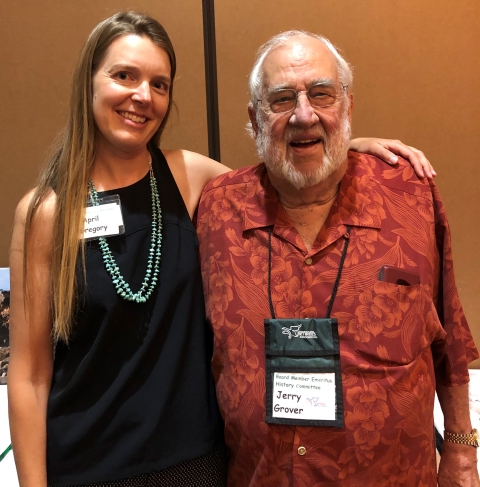The history of conservation is alive and thriving at D.C. Booth Historic National Fish Hatchery and Archives in Spearfish, South Dakota.
I’ve been fortunate to visit this historic hatchery several times through my career, and the hatchery and the people never fail to make a lasting impression on me as a public servant. It gives me a greater appreciation for the U.S. Fish and Wildlife Service, the public servants who have come before me, and for preserving our past.
Established in 1896, D.C. Booth Historic National Fish Hatchery and Archives, formerly Spearfish National Fish Hatchery, is one of the oldest operating hatcheries in the country dedicated to fish culture and resource management. Still raising and stocking trout in regional federal waters, the hatchery also serves as a cultural and educational resource. It is on the National Register of Historic Places and also houses the National Fish and Aquatic Conservation Archives, which serves the entire Fish and Aquatic Conservation program for the Service.
My first experience with D.C. Booth was in 2002, when the hatchery system was celebrating the “proud past and bright future” of our nation’s fisheries program. We were commemorating the accomplishments of the Fisheries Program and dedicating an historic rail car used for early transport of fish and eggs across the county. I met with retired federal workers as the annual Fish and Wildlife Service Retirees Reunion was part of this celebratory week.
We learned about early fish culture and how it is being preserved at this unique archive. Through conversations, retirees learned that we would be dedicating a new Fish Health Center Laboratory in Cook, Washington, the following year. They made plans to hold their annual reunion in Washington state for this exciting event.
In September 2003, we were thrilled to host nearly 300 retirees and their families at Spring Creek National Fish Hatchery in Underwood, Washington. Mamie Parker, the Service’s then-Assistant Director of Fisheries and Habitat Conservation, was keynote speaker and this group was fortunate to listen to her wisdom and stories of dedication. Just one year after meeting many of these individuals in South Dakota, the same familiar faces of the retirees surrounded me in celebration and the creation of more memories.
Fast forward 16 years. In 2018, I returned to D.C. Booth on a preservation mission. I spent six months gathering documents, records, annual reports, logbooks, journals, photographs and more from the six stations that comprise the Columbia River Gorge National Fish Hatchery Complex. Many hatcheries have historical documents stored in hot attics or damp rooms. These records of past practices, daily procedures or fish culture practices are slowly decaying over time. I came across annual reports dating back to 1924 that were literally falling apart in my hands. My Dodge Caravan was full for my drive across three states, as I delivered valuable information back to D.C. Booth for archiving and permanent storage.
I spent three weeks at this unique facility learning all the steps of archiving. What an opportunity to see this process from start to finish, working side by side with their curator, April Gregory. The rich history of the Service is alive in their archives, museum, rail car and historic D.C. Booth house. This history sparked something in me, a desire to preserve and protect all that has come before us, shaping what we are today as an agency: working with others, to conserve, protect, and enhance fish, wildlife and plants and their habitats for the continuing benefit of the American public.
Last month, I got another chance to visit D.C. Booth in yet another milestone celebration, the 150th anniversary of the National Fish Hatchery System. Bringing back some remaining documents and photos to the archives, but also to assist with yet another momentous Retiree Reunion. The first to occur in two years because of a global pandemic. The absence of not seeing one another for nearly three years made this reunion even more sweet! Past professionals came together to visit and rekindled friendships, remember old memories and create new ones.
Seeing the people who created and used many of the fish culture items in the archive collection and museum brought a new sense of appreciation of the past and all who came before me.
Jerry Grover has been connected with the Service for 63 years, both as an employee and a retiree. He received the 2021 Fish and Wildlife Service History Committee Award for his work with the Fish and Wildlife Service Retirees Association over the last 20+ years. Jerry has organized and attended every Retirees reunion that has occurred. The History Award recognizes significant contributions made to the preservation of the history and history of the Service. It was good to see him, visit and catch up after all these years.
The 2022 U.S. Fish and Wildlife Service History Award recipient was Craig Springer, U.S. Fish and Wildlife Service fish biologist and editor of the commemorative book, America’s Bountiful Waters, 150 Years of Fisheries Conservation and the U.S. Fish and Wildlife Service. Dale Bast was inducted as the 2022 American Fisheries Society Fish Culture Hall of Fame recipient.
The night was full of energy, emotion and passion for what we do, a common love for the resource and the need to carry this on into the future.
We all departed the following day to return to our homes and stations. It was a long drive back across Montana, Idaho and Washington to my little part of the world in the Columbia River Gorge.
I feel fortunate to have had this opportunity to participate in creating history, while also preserving it.



